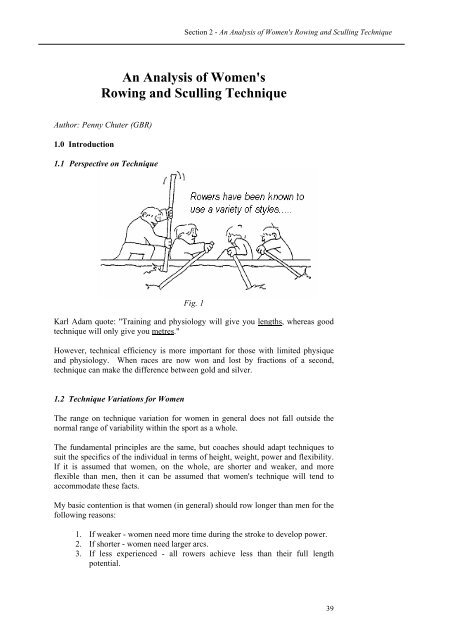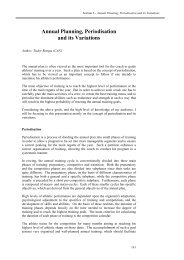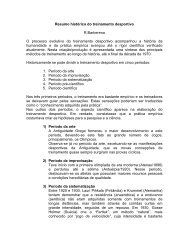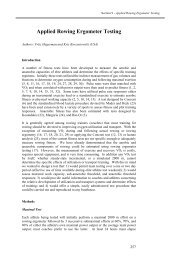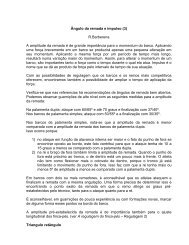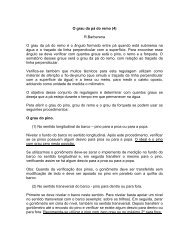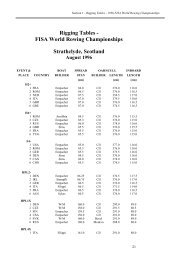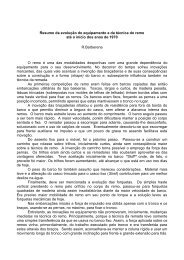An Analysis of Women's Rowing and Sculling Technique - Remo 2016
An Analysis of Women's Rowing and Sculling Technique - Remo 2016
An Analysis of Women's Rowing and Sculling Technique - Remo 2016
You also want an ePaper? Increase the reach of your titles
YUMPU automatically turns print PDFs into web optimized ePapers that Google loves.
FISA Coaching Development Programme Course - Level IIIIn addition, in general, coaches should allow for the facts that:As the stroke rate increases from winter to summer, there is a tendency forstroke length to shorten.As a race progresses from start to finish, fatigue also causes a tendency forthe stroke length to shorten.Overall length <strong>of</strong> stroke is the most important basic principle <strong>of</strong> boat propulsion.The force <strong>of</strong> the stroke <strong>and</strong> the number <strong>of</strong> strokes per minute are the other tw<strong>of</strong>actors. For women (where less strength may be a factor) length <strong>of</strong> stroke is evenmore important.At national <strong>and</strong> international level, however, my main observation <strong>of</strong> women'screws in general is that they row too short. The most obvious exception is thewomen <strong>of</strong> the former German Democratic Republic, who set an example for all tocopy <strong>and</strong> show clearly that with the right rigging <strong>and</strong> good technical coaching <strong>of</strong>the reach forward women can row long.However, it should be borne in mind that many women competing at internationallevel are not necessarily shorter or weaker than men. Table 1 shows that theaverage height <strong>and</strong> weight <strong>of</strong> the GDR women's team at the 1988 Seoul OlympicGames was 1.83 m (6'0") <strong>and</strong> 77.6 kg (12 st 3 lb or 171 lbs).Table 1: Average Heights <strong>and</strong> Weights <strong>of</strong> 1988 GDR <strong>Women's</strong> Olympic TeamHeightWeightTallest 1.88 m (6'2") Heaviest 84 kg (13 st 3 lbs or 185 lbs)Shortest 1.77 m (5'10") Lightest 68 kg (10 st 10 lbs or 150 lbs)Average 1.827 m (6'0") Average 77.6 kg (12 st 3 lbs or 171 lbs)Table 2: Height <strong>and</strong> Weight Data for World Championship Medallists - LightweightWomenHeight (minimum)WeightApprox. 1.67 m (5'6")Approx. 58 kg (9 st 0 lbs or 128 lbs)Table 3: Single Scull Time DifferencesAthlete ComparisonsWomen vs. MenLightweight Women vs.Heavyweight WomenLightweight Women vs. MenTime DifferenceApprox. 40 secondsslowerApprox. 15 secondsslowerApprox. 55 secondsslowerBeyond rowing larger arcs in the water, I have no recommendation for adaptation<strong>of</strong> technique especially for women. Adaptations should be specific to theindividual or crew.40
Section 2 - <strong>An</strong> <strong>An</strong>alysis <strong>of</strong> <strong>Women's</strong> <strong>Rowing</strong> <strong>and</strong> <strong>Sculling</strong> <strong>Technique</strong>1.3 Technical Developments - 1976-19901. Compressed <strong>and</strong> Orthodox <strong>Technique</strong>sThe greatest variation between national techniques worldwide reached its peak atthe 1976 Olympic Games in Montreal. There we saw the extreme <strong>of</strong> what hasbecome known as the Karl Adam "compressed" <strong>Technique</strong> shown by GBR <strong>and</strong>FRG crews especially. At the other extreme we saw the orthodox Englishtechnique displayed by GDR.By 1984 those nations using the compressed technique had come full circle <strong>and</strong> thetechnique variance between the different nations is now only one <strong>of</strong> slightdifferences <strong>of</strong> emphasis based on the orthodox GDR technique.2. Rigger HeightsSince 1976 riggers have gradually become higher. The reasons will be mentionedlater.3. Rigger SpreadsSince the 1960s, rigger spreads first moved towards larger spreads (smaller strokearcs). This trend also reached its peak around 1976. Since then, <strong>and</strong> particularlysince 1984, spreads have become smaller (larger stroke arcs) again, although not areversion to the pre-1960s situation. The rationale for these trends will also bediscussed later.4. <strong>Women's</strong> Distance - 2000mAfter the 1984 Olympic Games, the distance for women was extended to 2000m.This put a greater emphasis upon endurance <strong>and</strong> a lesser emphasis on "brute"strength, which has led to a change in women's physiques <strong>and</strong> in their technique.There is now much less emphasis on an exaggerated "lie back" at the finish in orderto use upper body weight as well as muscular strength to achieve a harder draw.This aspect is still, however, relevant to some women.5. Teaching <strong>of</strong> <strong>Technique</strong>Without doubt, the emphasis upon training which dominated the 1980s has resultedin less attention being paid to technique by coaches. The st<strong>and</strong>ard <strong>of</strong> precision <strong>and</strong>bladework, even <strong>of</strong> the GDR crews, is not as high now as it used to be. This is truein many nations, <strong>and</strong> perhaps it is time that coaches paid more attention to thecoaching <strong>of</strong> efficient technique.2.0 Basic Principles2.1 Body <strong>and</strong> Boat PrinciplesCompression vs. Reach (Orthodox) <strong>Technique</strong>A. The advantages <strong>of</strong> full leg compression:41
Section 2 - <strong>An</strong> <strong>An</strong>alysis <strong>of</strong> <strong>Women's</strong> <strong>Rowing</strong> <strong>and</strong> <strong>Sculling</strong> <strong>Technique</strong>In its extreme, compressed technique encouraged short stroke arcs, no body swingon the recovery, little slide control coming forward, the catch taken with the back<strong>and</strong> extreme fatigue <strong>of</strong> the leg muscles building up very quickly.Fig. 343
FISA Coaching Development Programme Course - Level IIIIn spite <strong>of</strong> this, many medals were won by nations using this technique in the early1970s.D. The Orthodox <strong>Technique</strong>In the orthodox technique, as exemplified by the GDR on Figure 3, there is less legcompression <strong>and</strong> more upper body reach. The catch is clearly taken with the legs;the body position at the catch is achieved at the beginning <strong>of</strong> the recovery bypivoting from the hips <strong>of</strong>f the backstops. The recovery is well controlled with theweight on the feet. Because the legs are not so compressed, there is less fatiguebuild-up in the leg muscles <strong>and</strong> the contribution <strong>of</strong> the back <strong>and</strong> arms is usedsequentially - legs/back/arms. There is more "lie-back" at the finish than in thecompressed technique with slight variations.E. The Reach <strong>Technique</strong>On Figure 3 this is referred to as the Rosenberg technique <strong>and</strong> is typical <strong>of</strong> USAcrews through the 1970s until the present day. It is so named from the Americancoach, Allan Rosenberg, who coached the USA men's 8+ which won the goldmedal at the 1974 World Championships in Lucerne.Today, however, it is most associated with the Italian technique, which featuresless leg compression still, with a marked body reach position at the catch which isachieved by good coaching <strong>of</strong> hip pivot <strong>of</strong>f the backstops to establish the bodyposition for the catch before moving up the slide.In addition, attention is paid to coaching full "reach" through the arms <strong>and</strong>shoulders in order to put the shoulder muscles, on full pre-stretch so that the "takeup"through the body, when the fast leg drive is applied to the oar h<strong>and</strong>le, isreduced to a minimum. In this technique, the advantages <strong>of</strong> the muscle-stretchmechanism are used through the upper body where the muscle fibres are slowtwitch<strong>and</strong> thus slow fatiguing. Figure 4 shows the typical upper body reach <strong>of</strong> theItalian technique.This technique also features a very strong leg drive from a more open knee anglewith the body compressed hard against the thighs with full body reach. It shouldbe emphasised that the body at the catch is "reaching" horizontal through theshoulders <strong>and</strong> not "overswinging" from the hips at the catch whereby the bodywould collapse <strong>and</strong> the catch would become more an inefficient upward lift than anefficient horizontal leg drive. Some would say the Italians "shoot their slides" butthe important guideline is to compare the speed <strong>of</strong> acceleration <strong>of</strong> the oar h<strong>and</strong>lewith the speed <strong>of</strong> the slide.This technique exploits a strong leg drive to achieve a force peak in the first third<strong>of</strong> the stroke which is what is ideally required, as we shall discuss later. Finally,there is slightly more "lie-back" at the finish than in the GDR technique.In summary, most current variations <strong>of</strong> technique fall within the range <strong>of</strong> the"orthodox" technique (GDR) <strong>and</strong> "reach" technique used by the Italians.Relatively speaking, however, this represents a small range <strong>of</strong> variation comparedto the extremes prevalent during the 1970s.<strong>Women's</strong> technique also falls within this range.44
Section 2 - <strong>An</strong> <strong>An</strong>alysis <strong>of</strong> <strong>Women's</strong> <strong>Rowing</strong> <strong>and</strong> <strong>Sculling</strong> <strong>Technique</strong>2. Higher Riggers - (Figure 5)By higher riggers I am actually referring to the height <strong>of</strong> the "sill" <strong>of</strong> the swivelabove the seat, <strong>and</strong> this also relates to the heights <strong>of</strong> the "sill" above the water.In my opinion, the development towards higher riggers, especially in sculling,<strong>of</strong>fers improved efficiency for a number <strong>of</strong> reasons:i. As can be seen from Figure 5, it is possible to achieve a longer stroke because thelength <strong>of</strong> reach <strong>of</strong> the arms is increased when the arms are more horizontal <strong>and</strong>assume the same height level as the shoulders.Equally, the same applies to the length <strong>of</strong> draw at the finish. Since the body issome 25 degrees past the vertical at the finish <strong>and</strong> in a slight "C" shape, it ispossible to draw longer at a higher level.ii. With the arms more on the same plane as the shoulders, the contribution <strong>of</strong> theshoulders <strong>and</strong> upper body to the first third <strong>of</strong> the stroke is clearly increased. Inaddition, the body is in a "stronger" position <strong>and</strong>, equally as important, the powerapplication is more in the horizontal plane.iii. The disadvantages, however, are that whilst the finishing draw may be longer, itis also weaker since it is more difficult to achieve a strong arm draw <strong>and</strong> a "wellcovered" finish with higher riggers. This applies more to shorter athletes who donot, therefore, sit "tall" in the boat - (some women).However, in my view, the positive benefits <strong>of</strong> increased length at the catch <strong>and</strong>increased power efficiency in the first <strong>and</strong> second third <strong>of</strong> the stroke far outweighthis disadvantage. A second disadvantage is that there is less stability <strong>and</strong> balancecontrol <strong>and</strong> thus, heights should be increased only gradually as the confidence <strong>and</strong>pr<strong>of</strong>iciency <strong>of</strong> the athlete increase. High riggers also encourage "dropped" wristson the recovery in sculling. This applies more to those with weaker wrists (somewomen) but this problem can be "coached-out" in conjunction with wriststrengthening exercises.45
FISA Coaching Development Programme Course - Level IIIDropped wrists on the recovery leads to other faults, particularly tight shoulders<strong>and</strong> a collapsed upper body. In addition, it encourages scullers to reverse theirh<strong>and</strong>s on the recovery.Finally, as with all developments, there are some who have taken this to anextreme, <strong>and</strong> I consider sculling heights <strong>of</strong> around 21 cm are too high <strong>and</strong> are wellbeyond the optimum for the best technical efficiency. Of course, specific heightsmust relate to the physique <strong>of</strong> the individual. I should also mention that in sweeprowing the advantages <strong>of</strong> higher riggers are less marked since, with two h<strong>and</strong>s onone oar h<strong>and</strong>le, the h<strong>and</strong>s are roughly either side <strong>of</strong> the centre line <strong>of</strong> the boat at theorthogonal point. Thus the inside h<strong>and</strong> - arm - <strong>and</strong> shoulder will be lower than theoutside h<strong>and</strong>. This asymmetry in rowing means that riggers cannot be as high as insculling. However, the trend has been in the same direction.3. <strong>Sculling</strong>i. Rigger Heights LevelOnly if the swivel heights are set level can you achieve symmetry at the catch(entry) <strong>and</strong> at the finish (release).If the riggers are set at different heights, scullers are <strong>of</strong>ten "out <strong>of</strong> time" withthemselves. In other words, the left <strong>and</strong> right sculls do not enter <strong>and</strong>/or leave thewater at the same time. You would be amazed how <strong>of</strong>ten this is the case. Inaddition, at the finish, it is more difficult to keep the higher scull "covered." At theextraction also, it is more difficult to extract <strong>and</strong> push away cleanly with the lowerscull.If the rigger heights are set at different levels, it only encourages scullers to scullwith their h<strong>and</strong>s one above the other during the "crossover" phases. If the h<strong>and</strong>sare level at the catch <strong>and</strong> at the finish, yet above one another during the crossovers,then clearly the boat will "rock" during every stroke. This increases "drag" on thehull <strong>and</strong> also causes more instability in the boat.ii. H<strong>and</strong>s Leading/FollowingThe debate continues as to whether or not the h<strong>and</strong>s, during the "crossover" shouldbe "above <strong>and</strong> below" or "leading <strong>and</strong> following." In GBR we have st<strong>and</strong>ardised"leading <strong>and</strong> following" with the left-h<strong>and</strong> leading at all times. This is alsost<strong>and</strong>ardised in FRA <strong>and</strong> BEL, <strong>and</strong> most nations (except GDR) have st<strong>and</strong>ardisedthe left-h<strong>and</strong> lead/on top.Before we st<strong>and</strong>ardised, I observed many thous<strong>and</strong>s <strong>of</strong> scullers taking part in longdistance races in the 1970s. I recorded 70% using the left-h<strong>and</strong> lead. On this basis,therefore, we st<strong>and</strong>ardised this in 1974. In addition, we know that technically thelower h<strong>and</strong> has a more difficult task because it is trapped under the upper h<strong>and</strong>.With most people being right-h<strong>and</strong>ed, therefore, it is logical to give the harder taskto the more dextrous h<strong>and</strong>. If everyone is taught the same way, there is no problem<strong>and</strong>, <strong>of</strong> course, st<strong>and</strong>ardisation is essential for crew sculling.In order to be efficient at the "crossover" during the propulsive phase, theasymmetry can be achieved either by a slight twist in the body <strong>and</strong> by advancingthe right shoulder earlier, or by keeping the body symmetrical <strong>and</strong> bending theright arm earlier. The best technique uses a combination <strong>of</strong> these.46
Section 2 - <strong>An</strong> <strong>An</strong>alysis <strong>of</strong> <strong>Women's</strong> <strong>Rowing</strong> <strong>and</strong> <strong>Sculling</strong> <strong>Technique</strong>Equally, on the recovery, it is essential that the left h<strong>and</strong> lead after the extraction.If the wrists are dropped on the recovery, then usually the h<strong>and</strong>s become reversed,<strong>and</strong> this is known in GBR as "knitting." We are assuming the "left-h<strong>and</strong> lead"technique is such that the right h<strong>and</strong> comes through first on the draw <strong>and</strong> the lefth<strong>and</strong> leads away first on the recovery. Thus the h<strong>and</strong>s remain in the samerelationship throughout. However, dropped wrists cause the right h<strong>and</strong> to leadaway first on the recovery whilst it is still the underneath h<strong>and</strong>. In this case, it isvery difficult to control the balance on the recovery. Since this aspect <strong>of</strong> scullingtechnique is universally taught badly or not taught at all, I will describe thecoaching sequence in depth.At the catch the body <strong>and</strong> h<strong>and</strong>s should be symmetric. As the "crossover" phaseapproaches, the RIGHT h<strong>and</strong> should draw a little earlier to come through first.During the draw phase, balance is entirely with the RIGHT h<strong>and</strong> <strong>and</strong>, therefore, theright h<strong>and</strong> should draw up at the finish to ensure that the boat does not drop downon the right h<strong>and</strong> side.At the extraction, the h<strong>and</strong>s should be level but immediately after the extraction theleft h<strong>and</strong> should be coached to lead away faster so that during the recovery"crossover" phase the left h<strong>and</strong> is leading.During the recovery, the balance <strong>of</strong> the boat is entirely controlled by the left h<strong>and</strong>,which should push down to stop the boat dropping towards the right h<strong>and</strong> sideagain. The key coaching points are:During the propulsive phase:RIGHT h<strong>and</strong> draw in firstRIGHT h<strong>and</strong> draw up during the drawDuring the recovery phase:LEFT h<strong>and</strong> lead away firstLEFT h<strong>and</strong> bear down to control balanceOn the draw:RIGHT h<strong>and</strong>RIGHT elbowRIGHT shoulderOn the recovery:LEFT h<strong>and</strong>LEFT elbowLEFT shoulderFIRSTFIRSTThe best exercise to get the h<strong>and</strong>s "right" during the propulsive phase is to try toget the sculler to draw through the crossover so that the right knuckles touch theunderneath <strong>of</strong> the left wrist, i.e., where your watchstrap would be.This is done only as an exercise <strong>and</strong> as such, the sculler must "feel" the rightknuckles touch the left wrist on every stroke.During the recovery phase, the fingers <strong>of</strong> the LEFT h<strong>and</strong> should be uncurled fromthe scull h<strong>and</strong>les <strong>and</strong> straightened. If this is done with dropped wrists, you willlose the scull!!! You, therefore, HAVE to flatten the wrist first so that the scull47
FISA Coaching Development Programme Course - Level IIIh<strong>and</strong>le is balanced under the bridge <strong>of</strong> the fingers only. The sequence is to flattenthe fingers <strong>of</strong> the left h<strong>and</strong> only on the grip as normal on the propulsive phase.It is a natural body phenomenon that if you extend one joint <strong>of</strong> a limb the otherjoints in the same limb will also extend. The extension <strong>of</strong> the fingers, therefore,naturally develops into an extension <strong>of</strong> the wrist, the elbow <strong>and</strong> the shoulder. Ifthis is done on the left side only, then a left-h<strong>and</strong> lead on the recovery will beachieved.Equally, if dropped wrists on the recovery is a problem, then the exercise can bedone with the fingers <strong>of</strong> BOTH h<strong>and</strong>s being extended during the recovery phase.Two months <strong>of</strong> coaching attention to the h<strong>and</strong>s using the coaching points <strong>and</strong>exercises I have demonstrated, should establish good h<strong>and</strong> technique at the"crossover" phases, as well as better balance control on the recovery.iii. FeatheringIt seems that feathering the blade on the recovery has gone out <strong>of</strong> fashion! Notablythe Italians hold their blades at a 45 degree angle to the water. The rationale forthis is that if the blade is feathered "flat" <strong>and</strong> happens to touch the water on therecovery, it could get "caught in" on the forward edge <strong>and</strong> this would cause a"shipwreck." However, if the blade touches the water whilst feathered at 45degrees it would simply "scuff" the water. Whilst this argument is valid, muchmore wind resistance is created if the blade is feathered at 45 degrees. In strongwinds it is also much harder to control the blades if held at 45 degrees. Finally, todo so means that the scull (or oar) h<strong>and</strong>les have to be gripped in order to be held ata 45 degree angle feather, whereas if they were allowed to rest flat on the sill <strong>of</strong> theswivel, which still gives 4 degrees from the horizontal (6 degrees with someswivels), the h<strong>and</strong>s can be relaxed on the recovery. Gripping causes a build-up <strong>of</strong>tension in the forearms which is not to be encouraged.I recommend feathering the blades flat (4 degrees) on the recovery <strong>and</strong> do notadvocate the current trend in most nations. This applies to rowing equally as tosculling <strong>and</strong> this is an aspect <strong>of</strong> efficient technique which women particularly canbenefit from at no extra cost.iv. Body SequenceWe have already discussed the biomechanics <strong>of</strong> the use <strong>of</strong> the legs <strong>and</strong> back inrelation to developments in technique in general. I would like to emphasise,however, that the essential difference between rowing <strong>and</strong> sculling is that the upperbody is used a little earlier during the propulsive phase [in sculling]. This isespecially required in single sculling since the single is the slowest boat <strong>and</strong>requires more upper body strength.b. Whilst the legs initiate the catch <strong>and</strong> the "drive" phase, the co-ordination <strong>of</strong> theupper body begins earlier in order to make more use <strong>of</strong> the back <strong>and</strong> shoulders inthe second phase <strong>of</strong> the stroke.c. In addition, the shoulders are used much more than in rowing with the sequencebeing: legs - back - SHOULDERS - arms, as opposed to legs - back - arms. Thisdifference needs to be brought out in coaching, especially with athletes who havelearned to row before they scull.48
Section 2 - <strong>An</strong> <strong>An</strong>alysis <strong>of</strong> <strong>Women's</strong> <strong>Rowing</strong> <strong>and</strong> <strong>Sculling</strong> <strong>Technique</strong>v. Hip PivotIn my opinion, the fundamental feature <strong>of</strong> rowing <strong>and</strong> sculling technique is the hippivot as the h<strong>and</strong>s lead away on the recovery.As a coach, if you can teach this to your athletes, the rest is easy.It is hard to teach because <strong>of</strong> the inter-relationship <strong>of</strong> the quadriceps muscles (kneeextensors/hip flexors) <strong>and</strong> the hamstring muscles (knee flexors/hip extensors).Since both muscle groups work over two joints (knee <strong>and</strong> hip) with opposingactions, they must be considered together.The length <strong>of</strong> the hamstrings are important in respect <strong>of</strong> the hip pivot at thebeginning <strong>of</strong> the recovery since the knees are held down, the hamstrings arestretched <strong>and</strong> as you pivot over, the hamstrings are further stretched round theoutside <strong>of</strong> the hip joint. This is why, when you try to touch your toes, you areinclined to bend your knees.Due to less <strong>and</strong> less physical education in schools, plus an increasing lack <strong>of</strong>general exercise caused by the development <strong>of</strong> the phenomenon known as "thecar," children nowadays are far less flexible than before the last world war. Thusthe hamstrings particularly are shorter. In sculling <strong>and</strong> rowing, short hamstringsmake it difficult to achieve a good hip pivot <strong>of</strong>f the backstop. Hamstring flexibilityshould be trained out <strong>of</strong> the boat by regular flexibility training. It is <strong>of</strong> majorimportance in our sport.I use the term hip pivot rather than body swing <strong>of</strong>f the backstop because it isimportant to coach the movement from the hips <strong>and</strong> not achieve it simply byflexing the back. In this way, the body angle for the catch can be established <strong>of</strong>fthe backstops without the back "collapsing" on the way forward.This is actually the hardest <strong>and</strong> most fundamental aspect or rowing <strong>and</strong> sculling,<strong>and</strong> a great deal <strong>of</strong> time should spent coaching the athlete to master it. Hip pivot isessential to the achievement <strong>of</strong> a good recovery sequence <strong>of</strong> h<strong>and</strong>s - body - slide.Time is needed <strong>and</strong> the emphasis should be: h<strong>and</strong>s - BODY - slide.vi. The RecoveryThe way to achieve time <strong>and</strong> control on the recovery is to coach for EVEN speedon the slide. A good focus <strong>of</strong> attention to achieve this is to coach the athlete(s) totry to match the speed <strong>of</strong> the wheels on the slide to the speed <strong>of</strong> the boat. Whenequilibrium is achieved between these two speeds, then you get perfect harmony<strong>and</strong> the benefit is both relaxation <strong>of</strong> the body <strong>and</strong> the best "run" out <strong>of</strong> the boatduring the recovery phase.Few coaches relate to the "feel" <strong>of</strong> the "run" <strong>of</strong> the boat or the speed <strong>of</strong> the wheelson the slide (wheels is the key word here) <strong>and</strong> women particularly respond toattentional focus through the medium <strong>of</strong> "touch" <strong>and</strong> "feel."vii. The CatchI am not a believer in "bell notes" at the catch or indeed a 'hit" catch. The best wayto achieve an efficient "lock-on" to the water without bouncing the boat backwards,49
FISA Coaching Development Programme Course - Level IIIor destroying the run, is to pick up the catch rather like a drive stroke in tennis. Intennis you would never coach someone to hit AT the ball, but rather to drivethrough it. In the same way, the catch should be almost a squeeze from full stretch.If all the muscles <strong>of</strong> the arms, shoulders <strong>and</strong> upper body are on full pre-stretchbefore the catch, then as the legs drive <strong>of</strong>f the stretcher there will be instantaneoustransfer to the blade in the water. Rather like a bow <strong>and</strong> arrow, the arrow isreleased when the bow is fully stretched. Scullers <strong>and</strong> crews who pick up the catchfrom full reach, <strong>and</strong> with a large arc forward, can achieve this "driving through"effect rather than just exploding <strong>of</strong>f the stretcher <strong>and</strong> hitting the catch in anuncoordinated manner which "checks" the boat speed <strong>and</strong> fatigues the leg musclessooner.I consider that efficient technical application <strong>of</strong> the catch is <strong>of</strong> particularimportance to women or those who are less strong. A longer arc forward,combined with a fast "pre-stretched" catch, can achieve maximum benefit from thefirst part <strong>of</strong> the stroke with minimum build-up <strong>of</strong> lactate.4. Horizontal Movement <strong>of</strong> the Centre <strong>of</strong> Gravity (CG) - (Figures 6-7)To return now to the other basic biomechanical principles related to the boat <strong>and</strong>the body, it is important to reduce the range <strong>of</strong> horizontal movement <strong>of</strong> the CG asmuch as possible.The figure shows that when using the compressed (Adam) technique the CG movesthrough a greater range at the catch. In addition, the longer the range <strong>of</strong> movement,the more difficult it is to control the velocity <strong>of</strong> movement <strong>of</strong> the body within theboat. Clearly, movement towards the bow is required in order for the legs toinitiate <strong>and</strong> carry through the drive phase <strong>and</strong> the need to drive down fast toaccelerate the oar h<strong>and</strong>le <strong>and</strong> thus the boat. However, on the recovery, the velocity<strong>of</strong> movement up the slide can be controlled as mentioned earlier. In order to"flatten" the speed fluctuation curve (Figure 7) on the recovery phase, it is essentialto achieve a "slow" <strong>and</strong> "even" speed on the slide. The flatter the curve, the lessresistance there will be on the hull since resistance increases by the square <strong>of</strong> thespeed such that boat speed acceleration should be kept to a minimum.These mechanical principles underline the importance <strong>of</strong> coaching slide control onthe recovery as described earlier.50
Section 2 - <strong>An</strong> <strong>An</strong>alysis <strong>of</strong> <strong>Women's</strong> <strong>Rowing</strong> <strong>and</strong> <strong>Sculling</strong> <strong>Technique</strong>5. Vertical Movement <strong>of</strong> the Centre <strong>of</strong> Gravity (CG) - (Figure 8)Movement <strong>of</strong> the CG in the vertical plane causes the boat to "pitch" fore <strong>and</strong> aft<strong>and</strong> this also increases resistance on the hull <strong>and</strong> decreases boat speed. As can beseen from Figure 8, excessive lie-back at the finish lowers the CG. Peter-MichaelKolbe who has very little lie-back at the finish, <strong>and</strong> who also displays little bodyreach forward has one <strong>of</strong> the lowest vertical movements <strong>of</strong> CG recorded. This canpartly be explained by Figure 9 which shows the range <strong>of</strong> body swing at the catch<strong>and</strong> the finish <strong>of</strong> the singles finalists in the 1981 World Championship in Munich.However, it should be pointed out that they were using sliding rigger boats. Thefigure does, however, demonstrate the point.Fig. 9Women are, in general, markedly less strong than men in the upper body <strong>and</strong> thustend to lie back further at the finish in order to use upper body weight behind thedraw to supplement lack <strong>of</strong> upper body strength.It is in this respect, therefore, that coaches <strong>of</strong> women (if they are weak in the upperbody) must compromise between the disadvantages <strong>of</strong> the lie-back in respect <strong>of</strong>increased power application to the blades.51
FISA Coaching Development Programme Course - Level IIIIn general, the need for "brute force" on the draw has reduced in favour <strong>of</strong> moreendurance since the distance for women has been extended to 2000 m. I would notadvocate that technique for all women need to exaggerate the lie-back at the finish,but clearly it may be beneficial for some. Coaches should use their own experience<strong>and</strong> intuition in this respect after consideration <strong>of</strong> the individual athletes beingcoached.Fig. 10Figure 10 shows the average body angles at the catch <strong>and</strong> the finish in sculling as:+30 degree - catch-25 degree - finishIn rowing, in general, there is more body swing at the catch <strong>and</strong> less at the finishgiving probable angles <strong>of</strong>:+35 degree - catch-20 degree - finishHowever, I am wary <strong>of</strong> quoting such averages since so much depends on backflexibility, hip flexibility <strong>and</strong> limb lengths. Again, coaches should evaluate theindividual/crew <strong>and</strong> coach the most efficient body technique achievable, bearing inmind the limits <strong>of</strong> the various principles.2.2 Oar Principles - (Figures 11-16)During the 1970s <strong>and</strong> 1980s rigger spreads have changed. In the 1970s arcsbecame smaller (larger rigger spreads). The rationale for this was that, through thestroke arc, the components <strong>of</strong> propulsive force reduced either side <strong>of</strong> theorthogonal (Figure 11). Maximum efficiency was 20° either side <strong>of</strong> the orthogonalwhilst at 50° to 60° either side the loss <strong>of</strong> efficiency was nearly 50% <strong>of</strong> that at theorthogonal point.52
Section 2 - <strong>An</strong> <strong>An</strong>alysis <strong>of</strong> <strong>Women's</strong> <strong>Rowing</strong> <strong>and</strong> <strong>Sculling</strong> <strong>Technique</strong>Fig. 11In order, therefore, to achieve a long stroke (distance boat moved), whilst usingonly a shallow arc, rigger spreads were increased <strong>and</strong> then longer oars wereintroduced (see Figure 12).Fig. 1253
FISA Coaching Development Programme Course - Level IIIIn order to achieve the best results from larger spreads with longer oars/sculls, therower needs to be very strong <strong>and</strong> very explosive because the shallower the angle<strong>of</strong> the pickup at the catch, the faster you have to lock-on to the water. Thisexplosive technique with a smaller stroke arc was also a feature <strong>of</strong> crews whoexaggerated the compressed Adam technique. The necessity to "hit" the catch fastled to early fatigue <strong>of</strong> the leg muscles <strong>and</strong> also to "checking" <strong>of</strong> the run <strong>of</strong> the boatat the catch.Fig. 13Figure 13 shows the real movement <strong>of</strong> the blade in relation to the boat. Consideredin this way the former argument in respect <strong>of</strong> the efficiency <strong>of</strong> the arc angles, isless strong. The boat is moved past the blade rather than the blade past the boat.Finally, if we imagine that in this figure (13), the boat is also moving forwardrelative to the water, then this further undermines the arc angles argument.We must remember that:• The boat is moving relative to the water.• The blades are moving relative to the boat.• Also the athlete's body is moving in relation to the boat.It is because it is difficult, using figures, to demonstrate the actual mechanics <strong>of</strong> theboat <strong>and</strong> the blade relative to the water that the arc angles rationale has beenmisinterpreted for so long. Now we have video <strong>and</strong> can also record arc angles <strong>and</strong>blade force, so we can underst<strong>and</strong> the principles more clearly.The best way to appreciate the real movement <strong>of</strong> the blade in relation to the boat<strong>and</strong> to the water is to analyse video taken from directly above a crew - preferablyfrom a helicopter moving at the same speed.From above you can see the effect <strong>of</strong> hydrodynamic lift on the blade at the catch,<strong>and</strong> the "slip" round the neck <strong>of</strong> the blade as the blade tip moves away from theboat laterally before the orthogonal <strong>and</strong> then moves back towards the boat after theorthogonal. (See Figures 13-16)54
Section 2 - <strong>An</strong> <strong>An</strong>alysis <strong>of</strong> <strong>Women's</strong> <strong>Rowing</strong> <strong>and</strong> <strong>Sculling</strong> <strong>Technique</strong>Fig. 14It is interesting to note that Figure 15 was copied from a book entitled The Way <strong>of</strong>a Man With a Blade, which was written in 1957 by the famous British coach"Jumbo" Edwards. So the concept <strong>of</strong> hydrodynamic lift is not new. However,consideration <strong>of</strong> its relevance to boat propulsion has been given more considerationin recent years.To appreciate the effect you should remember that as the blade enters the water atthe catch, the boat is moving forward such that the blade actually pierces the waterend-on, i.e., the blade is actually pushed into the water tip first by the forwardmovement <strong>of</strong> the boat. The greater the arc angle at the catch, the more this is thecase. Thus water flows up the blade towards the shaft (Figure 16).Fig. 15-1655
FISA Coaching Development Programme Course - Level IIIBecause <strong>of</strong> the hydrodynamic shape <strong>of</strong> the blade pr<strong>of</strong>ile presented to the water,thrust is produced at 90 degrees to the blade.This is the same principle by which an aircraft takes <strong>of</strong>f. The aeroplane acceleratesalong the runway <strong>and</strong> because <strong>of</strong> the aerodynamic shape <strong>of</strong> the wings, there isvertical thrust which, above certain ground speeds, causes enough thrust to lift theaeroplane <strong>of</strong>f the ground.Bearing in mind the effect <strong>of</strong> both hydrodynamic lift <strong>and</strong> the fact that the boat islevered past the blade, it is clear that larger arcs forward are not a disadvantage asformerly suggested.Finally, we should remember that there is a limit to the explosive power <strong>of</strong> thehuman being, especially for 5-1/2 minutes or more <strong>of</strong> effort. Also that a longerstroke with a smoother, wider force:time-curve pr<strong>of</strong>ile will enable an athlete topropel a boat faster for a longer period <strong>of</strong> time than a shorter stroke with a higherforce:time-curve peak.The latter requires more explosive power from the athletes, brings on lactatefatigue faster, <strong>and</strong> causes greater boat speed fluctuations.Thus, during the 1980s, stroke arcs have increased again, particularly in sculling,<strong>and</strong> rigger spreads have reduced. The longer oars are, <strong>of</strong> course, still used by thestronger <strong>and</strong> taller athletes, but those who are weaker <strong>and</strong>/or shorter are bestadvised to use shorter oars/sculls with a narrower spread in order to achieve alarger arc with a manageable work ratio.Observations <strong>of</strong> current world class crews confirm the increased efficiency <strong>of</strong>larger arcs <strong>and</strong>, as I suggested earlier, length <strong>of</strong> stroke is the most importantprinciple <strong>of</strong> boat propulsion.Women particularly, should therefore, seek to establish a long stroke both byachieving maximum upper body reach at the catch, <strong>and</strong> by ensuring that the arcsize is the first consideration when deciding what spread to use.Many women are using spreads which are too wide, simply because they are usingoars or sculls which are too long. The result is a short stroke, an impact orientatedcatch, <strong>and</strong> too much inboard overlap, which has the effect <strong>of</strong> further shortening thestroke. More on rigging later.2.3 Force:Time-Curves - (Figures 17-21)The final consideration <strong>of</strong> basic principles relates to the force:time-curve (FT)pr<strong>of</strong>iles. These vary from individual to individual. They vary with the sameindividual depending on the rate <strong>of</strong> striking, the spread <strong>of</strong> the boat <strong>and</strong>, therefore,the type <strong>of</strong> boat as well.I only have time to consider the fundamental aspects <strong>of</strong> FT curves as they relate totechnique in general rather than as they relate to individuals.56
Section 2 - <strong>An</strong> <strong>An</strong>alysis <strong>of</strong> <strong>Women's</strong> <strong>Rowing</strong> <strong>and</strong> <strong>Sculling</strong> <strong>Technique</strong>Because we cannot pull on the oar h<strong>and</strong>le unless it is in front <strong>of</strong> us, <strong>and</strong> because theleg drive provides the main source <strong>of</strong> power applied to the h<strong>and</strong>le, it is clear thatpeak power cannot be achieved at the orthogonal point <strong>of</strong> the arc. Figure 17 showsa typical FT curve pr<strong>of</strong>ile <strong>and</strong> you can see that the peak force occurs well beforetheFig. 17Orthogonal (intermittent line). From Figure 18 we can see that the force peak is inthe middle third <strong>of</strong> the arc but that two thirds <strong>of</strong> the arc occurs before theOrthogonal. Figure 19 shows an FT curve in relation to the blade <strong>and</strong> bodypositions.Fig. 1857
FISA Coaching Development Programme Course - Level IIIFig. 19Figure 20 shows the individual FT curves for the legs (knee angle), back (hipangle) <strong>and</strong> arms (elbow angle), which better explains why the FT curve peak, is 30-40 degrees before the orthogonal point.Fig. 20If presented with an individual FT curve, we know that further improvement inpower output would be indicated by a larger area <strong>of</strong> impulse under the curve. If weassume that with improved strength, fitness <strong>and</strong> technique we could increase thearea under the curve, how should we do it? Should we increase the peak force orshould we broaden the current shape?58
Section 2 - <strong>An</strong> <strong>An</strong>alysis <strong>of</strong> <strong>Women's</strong> <strong>Rowing</strong> <strong>and</strong> <strong>Sculling</strong> <strong>Technique</strong>Without doubt, I would recommend that the current shape should bebroadened <strong>and</strong> maintained for longer.In respect <strong>of</strong> larger stroke arcs, I should emphasise that they have not increased atthe finish, <strong>and</strong> about +37 behind the orthogonal (see Figure 18) is optimal. Sincethe boat is moving fast through the water, any arc larger than about 40 degreesresults in the boat "towing" the blade out <strong>of</strong> the inside <strong>of</strong> the puddle such that theblade acts like an inefficient "flipper" being dragged along behind. Clearly thisacts as a brake on the boat speed.In general, at the catch scullers such as Karpinnen can reach -70 degrees from theorthogonal, whereas -60 degrees is the average in sculling. In rowing it is a littleless <strong>and</strong> women seem to be some 10 degrees shorter at the catch than men. This,however, could be changed by rigging.Consideration <strong>of</strong> length <strong>of</strong> stroke, <strong>and</strong> the method <strong>of</strong> power applications at thecatch, in the light <strong>of</strong> FT curves further underlines the importance <strong>of</strong> a longer strokewith larger arc angles at the catch which gives "time" for a smooth, sustainedpower output over a longer time. Again, this emphasis is more applicable toweaker people who do not have so much latent explosive power. Even with thestrongest men, a technique emphasising high peak force with a shorter stroke burnsyou out very quickly. In addition, hydrodynamically it is not the most efficientway to move a boat.The data on FT curves, which has accumulated during the 1980s, again endorsesthe greater efficiency <strong>of</strong> a long stroke giving time to develop a smooth "full" FTcurve. Both the mechanical, biomechanical <strong>and</strong> physiological data support thefundamental importance <strong>of</strong> a long stroke.The table in Figure 21 first published at the FISA Coaches Conference in Athens inJanuary 1991 by Dr. Schwanitz <strong>and</strong> Dr. Roth (biomechanist <strong>and</strong> physiologist fromthe GDR) presents an overview <strong>of</strong> the mechanical, biomechanical <strong>and</strong>physiological basis <strong>of</strong> rowing technique. <strong>An</strong>alysis <strong>of</strong> this table could be the basis<strong>of</strong> a whole weekend <strong>of</strong> discussion, so I include it here only for your future personalanalysis.2.4 RiggingIt is my contention that many women at both club <strong>and</strong> international level(especially lightweights) are using inefficient rigs in respect <strong>of</strong> the following:• Too large spreads causing too short stroke arcs• Too long oars/sculls• Too long oars/sculls INBOARD giving too much overlapWe have already discussed the advantages <strong>of</strong> a large arc <strong>and</strong> therefore I will onlyadd some comments on overlap here.When choosing a rig the priority order is as follows:1. Decide the spread, which will allow you to scull/row the size <strong>of</strong> arc yourequire.59
FISA Coaching Development Programme Course - Level III2. Decide the length <strong>of</strong> the oar/scull OUTBOARD that will give you anappropriate leverage from the size <strong>of</strong> your arc.3. Decide the overall length <strong>of</strong> the oar/scull by adding the INBOARD lengthrequired to give you an overlap appropriate to your overall height <strong>and</strong>particularly your leg length.i. OverlapBy this, I am referring to the amount by which the inboard overlaps the centre line<strong>of</strong> the boat at the orthogonal point.Inboard length has little effect on gearing. It is the outboard length <strong>of</strong> the oarwhich is the major leverage factor. This is why we usually quote gearing as spread(minus 2 cm) in relation to outboard. 2 cm are subtracted from the spread (4 cm insculling) to allow for the difference between the pin (fulcrum) <strong>and</strong> the inside edge<strong>of</strong> the swivel against which the oar/scull collar rests. <strong>An</strong>y length <strong>of</strong> inboard whichoverlaps the centre line <strong>of</strong> the boat, is primarily related to factors other thangearing.In rowing average overlap is 32 cm. Too long inboard restricts arc length at thecatch. Equally, too little causes a weak draw because the outside shoulder, forearm<strong>and</strong> h<strong>and</strong> cannot draw directly behind the h<strong>and</strong>le since the end <strong>of</strong> the h<strong>and</strong>le willswing inside the outside line <strong>of</strong> the body. This also encourages the outside h<strong>and</strong> toroll round the end <strong>of</strong> the h<strong>and</strong>le - then the outside elbow to drop - then the outsideshoulder to collapse - <strong>and</strong> finally the rower to lean out, or away from the rigger atthe finish. This reduces further the power <strong>of</strong> the draw <strong>and</strong> may also cause balanceproblems.Overlap is, therefore, an important dimension to consider <strong>and</strong> should not be toolong or too short. In general, shorter athletes need less overlap.In sculling also, too much overlap reduces the arc angle at the catch <strong>and</strong> severelyreduces the length <strong>of</strong> the draw.The average overlap in sculling is about 22 cm. (The amount by which both scullh<strong>and</strong>les overlap each other.) In the faster moving boats, where more room isneeded to extract cleanly <strong>and</strong> move the h<strong>and</strong>s away quickly, overlap may be lessthan this. However, overlap is a very individual dimension depending very muchon leg-strength.Tall athletes with long legs need larger overlaps because they have the leg length to"uncross" the overlap as their legs straighten at the finish. Indeed, if they had toolittle overlap, they would be so far back from the scull h<strong>and</strong>les at the finish thatthey would simply be pulling the scull h<strong>and</strong>les inboard <strong>and</strong> the collar away fromthe swivel.For shorter athletes, however, <strong>and</strong> this means many women, this is reversed. If youhave shorter legs then you do not have the leg length to "uncross" the overlap at thefinish. Many women that I observe sculling have barely 10 cm between theirh<strong>and</strong>s at the extraction because their inboard scull lengths are too long <strong>and</strong> theyhave too much overlap.60
Section 2 - <strong>An</strong> <strong>An</strong>alysis <strong>of</strong> <strong>Women's</strong> <strong>Rowing</strong> <strong>and</strong> <strong>Sculling</strong> <strong>Technique</strong>This means that the finish cannot be drawn hard <strong>and</strong> long, <strong>and</strong> the sculler'sshoulders are "tight" <strong>and</strong> hunched because she cannot open-up <strong>and</strong> draw back theshoulders properly at the finish.This situation occurs because shorter scullers follow the average guidelines for"overlap" <strong>and</strong> do not realise that overlap needs to be less than average for shorterathletes. Overlaps <strong>of</strong> 17-19 cm are more appropriate for shorter athletes.I believe that if many shorter women checked their "set-ups" they would find thatprobably they would be better with 296 cm sculls instead <strong>of</strong> 298 cm, the latterbeing more appropriate for taller scullers on st<strong>and</strong>ard overlap.ii. <strong>Women's</strong> Rigging Tables - 1988 Olympic Games <strong>and</strong> World ChampionshipsMy second comment in respect <strong>of</strong> women's rigging is that I believe that manywomen's crews <strong>and</strong> single scullers are using spreads, which are too large. Thisreduces the length <strong>of</strong> stroke arc <strong>and</strong> requires a very explosive technique not suitedto weaker athletes.Here are two examples <strong>of</strong> rig from the 1988 Olympic Games <strong>Women's</strong> Singlestogether with the heights <strong>and</strong> weights <strong>of</strong> the athletes concerned:Table 4: <strong>Women's</strong> Rigging Tables - 1988 Olympic Games Single ScullsA.B.Height Weight Spread Sculls Outboard Inboard Overlap1.83 m80+ kg(13+ st or 158 cm 298 cm 210.5 cm 87.5 cm 21 cm(6'0")175+ lbs)1.75 m(5'8")64 kg(10st or141 lbs)158 cm 296 cm 207cm 89 cm 24 cmBefore commenting further, I should point out that these tables cannot beguaranteed as correct <strong>and</strong> there could well have been misidentification <strong>of</strong> boat<strong>and</strong>/or sculls for each athlete. However, the figures are useful as an example.Comments:1. Athlete A is much taller than athlete B <strong>and</strong> yet they are on the same spread.With a much shorter reach, therefore, athlete B would have a much shorter strokearc than athlete A.2. Athlete B has a much shorter outboard no doubt to give her an easier gearingsince she is a lightweight. However, with the same spread <strong>and</strong> sculls 2 cm shorteroverall, she still has very long inboard dimensions because <strong>of</strong> the short outboards.This gives her an extremely large overlap <strong>of</strong> 24 cm which will further restrict herlength <strong>of</strong> stroke both at the catch <strong>and</strong> at the finish. With shorter legs than athlete Bthe situation is even worse.3. Does athlete B really need such a short outboard lever? I doubt it, but if shedoes, should she use even shorter sculls or a larger spread in order to solve theproblem? I would not choose a larger spread.61
FISA Coaching Development Programme Course - Level III4. Again, it is likely that these dimensions are not correct, but the rigging "set-up"<strong>of</strong> athlete B is typical <strong>of</strong> the problem I observe world-wide with the rigging <strong>of</strong>shorter women.5. After the women's distance was increased to 2000 m in 1985, I expected achange in women's spreads which would reflect greater endurance efficiency overthe longer distance <strong>and</strong> less orientation towards "brute power" rowing. In otherwords, I would have expected women to use narrower spreads than previously <strong>and</strong>thus to use shorter oars/sculls as well.6. It is interesting that the women (<strong>and</strong> men) <strong>of</strong> the GDR have kept their spreadsthe same throughout the last twenty years with a few exceptions in the single scullto allow for individual extremes. They have remained narrower <strong>and</strong> we have allobserved the very long efficient stroke arcs demonstrated by the GDR women.7. The questions should be asked: "Is it simply natural conservatism which has keptwomen's rigging the same for 2000 m as it was for 1000 m?" There is, <strong>of</strong> course,always a reluctance to experiment, <strong>and</strong> we know that in our sport it is difficult tomeasure objectively the results <strong>of</strong> rigging changes, particularly in the short-term.However, over the last couple <strong>of</strong> years, I have seen some signs <strong>of</strong> change in thedirection I would expect. Perhaps the points I have raised today, in conjunctionwith my appraisal <strong>of</strong> technique, might stimulate all the coaches here to review theirown views on technique <strong>and</strong> particularly to have a look afresh at the riggingimplications for women.3. Summary1. <strong>Technique</strong> - Generali. Women need better (more efficient) technique.ii. Coaches <strong>of</strong> women should not take technique for granted - teach well <strong>and</strong> teachmethodically.2. <strong>Technique</strong> - Key Points for Womeni. Long Stroke ArcAchieved by:• Body <strong>Technique</strong> - Reach through shoulders• Rigging - Narrower spreads to give larger arcsii. Hip Pivot - Basis for teaching techniqueiii. Shoulder Reach/Stretch - Essential for an efficient catchiv. Leg Drive at Catch - Fundamental basis <strong>of</strong> propulsive phasev. Lie-Back at Finish - May still be needed by some weaker <strong>and</strong>/or shorter womenvi. Feathering - If properly taught, it uses no extra energy, so why not feather flat?vii. <strong>Sculling</strong>• Left h<strong>and</strong> lead• H<strong>and</strong>s leading <strong>and</strong> following• Body co-ordination - legs - back - SHOULDERS - arms62
Section 2 - <strong>An</strong> <strong>An</strong>alysis <strong>of</strong> <strong>Women's</strong> <strong>Rowing</strong> <strong>and</strong> <strong>Sculling</strong> <strong>Technique</strong>3. Riggingi. Riggers Higher - Especially in scullingii. Riggers Level - In scullingiii. Spreads - Are they too large giving a shorter arc?iv. Oars/Sculls - If spreads were narrower, oars/sculls should be shorterv. Overlap - Should be less for shorter athletes particularly in sculling4. Recommendations for WomenWomen should endeavour to row/scull larger stroke arcs for the following reasons.A longer stroke:• Is much more efficient mechanically <strong>and</strong> biomechanically.• Requires a less "impact" orientated catch.• Encourages a larger arc angle forward which makes it easier to pick-up thecatch.• Provides a longer time <strong>of</strong> stroke during which to develop power.• Encourages a more even application <strong>of</strong> power.• Creates less lactate build-up <strong>and</strong>, therefore, is less fatiguing throughout therace.• Creates less boat speed fluctuation <strong>and</strong>, therefore, less drag on the hull.63


